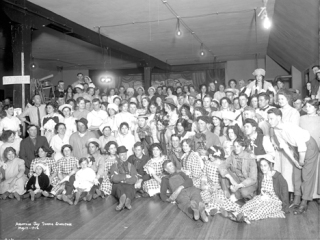“The Jaytaown Stampeed att Mystique Haul Saturday night was shur a good tyme,” the May 24, 1912 Auburn Republican proclaimed in its finest hayseed style. “Most awl the boys and theyer girls was thare and the way thaye laft and danced was shure a caushin.
“…Hezikiah Goin dressed liked a counstable with a reel starr on his buzzum, but Rube McRee dun the reel arestin uv them as dident behev proper. Thar was lots more from Punkinville and Happy Holler and Briar Ridge and uther townes wich tyme and space forbids us to speak uv … The happy throng went hum befor the cocks crowed, but not much.”
That there was such a dance 19 years after the pioneer town of Slaughter shed its gruesome name for the more pleasing “Auburn” says something important. It tells us that by 1912, Auburn’s townfolk felt comfortable enough with their heritage to slip into bumpkin clothes, black out a tooth or two and dance the night away poking light-hearted fun at a past that was already “way back when.”
Arthur Condict Ballard, an Auburn pioneer and photographer, was there that spring night 97 years ago to capture in his lens the merrymaking of once vibrant people otherwise lost to time.
Ballard’s photo, notable for its early use of flash, is among the most fascinating in the collection of pictures of muddy streets, long dresses, horse-drawn milk wagons and logging that he took from Auburn’s earliest days through the 1920s. And until April 14, those photos will make up the White River Valley Museum’s latest exhibit, “Ilalko, Then Slaughter, Now Auburn: Historic Photographs of Place.”
Each of the more than 600 photos offers a powerful contrast of then and now: a rickety bridge spanning the White River at today’s intersection of Auburn Way North and East Main; the long demolished Ohio Hotel; the Del Monico Restaurant; nameless people smiling shyly into Ballard’s camera.
“There’s a picture of the river that to me is the most remarkable picture,” said Museum Director Patricia Cosgrove. “You begin to see what the world looked like before we were so densely populated and covered the ground with concrete. It was bucolic and green and quite glorious.”
“It is the work of what you might call a photographer for his own purposes,” said Guest Curator Kenneth (Greg) Watson. “He was taking people’s portraits. Arthur Ballard was a born documenter.”
Ilalko is the native name of an Indian village at the base of Lea Hill near the former confluence of the White and Green rivers. Ballard identified himself as “A poor man from Ilalko,” in a notable speech he gave in the Muckleshoot language.
He took a lifelong interest in Native Americans.
“He was a researcher of Native American Culture, and it strikes me he was born a few months after the Battle of the Little Bighorn in July 1876,” Watson said. “It was the worst time in history for somebody to come along who wanted to feel sympathetic toward Native American people. That’s the way we think of him the most. He did a tremendous amount of linguistic and cultural research. For a white guy, he was definitely someone as from here as you can get, and he lived all of his life or as much as he could of it here. He was very, very committed and concerned for this community.”
Ballard’s Auburn roots go deep.
His parents, Levi and Mary Ballard, platted the town of Slaughter and lived in a house on Auburn Avenue, which was torn down in 1938 to make way for the Auburn Post Office, today the King County Department of Health. He earned a degree from the University of Washington, then taught school for several years in Eastern Washington before returning to Auburn.
After Ballard’s death in May of 1962 at age 86, his family discovered in his home boxes of nitrate film and glass negatives among a lifetime of carefully documented, assiduously collected materials. The negatives are in the legal possession of several of his grandchildren in California, but are on display at the museum.
“I have no surviving pictures of him taking pictures or elaborate notes on that, nor as far as I know have any cameras he used survived,” Watson said. “But many of these pictures are labeled in his handwriting, so we have no reason to believe he did not take all of them. A couple of them were used for other purposes.
“… I don’t know who Ballard learned about taking photographs from. It is possible he was self taught. If you look in the Montgomery Ward Sears catalogues of the time, you’ll see that you could order the plates, processing chemicals and the whole rig as of the 1880s.”
Cosgrove the exhibit has several purposes.
“First, we want to share with the public the remarkable collection of photos we have uncovered. Also, downtown Auburn, I think, has disappointed people in the last few years; people see it as maybe dying, while really it is poised for tremendous growth and change, which is part of what has been going on here for maybe 150 years. It seemed like a good time to show the town’s growth from a village to a little western pioneer town to the boom town of the 20s. You can take a leap and contemplate the city in a decade with a quite revitalized, different downtown.”


